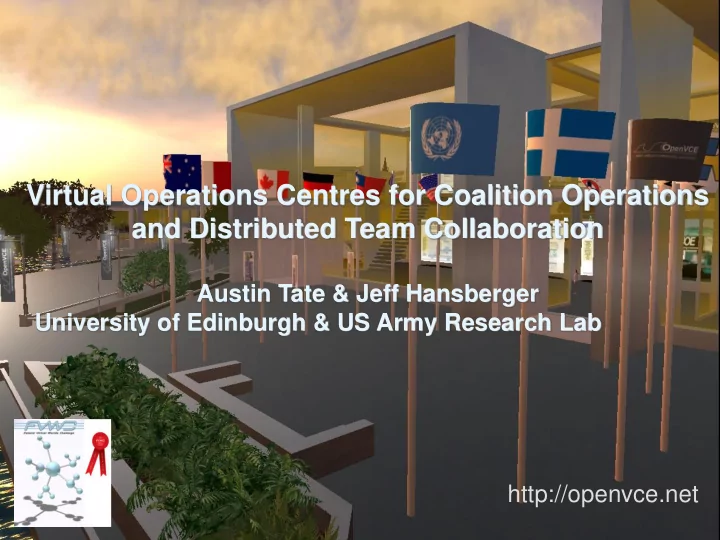

Virtual Operations Centres for Coalition Operations and Distributed Team Collaboration Austin Tate & Jeff Hansberger University of Edinburgh & US Army Research Lab http://openvce.net
Project to provide a Virtual Collaboration Environment for the WoSCR Community • Support for Whole of Society Crisis Response Community • Cognitive Work Analysis of Requirements and Technologies • Experiments with Virtual Collaboration Environment (VCE): – Web-based portal – Virtual interaction space – Community tools – Collaboration protocol • USJFCOM, US ARL HRED, CMU, U.Virginia, U.Edinburgh, Perigean Technologies
Cognitive Work Analysis – Task Independent Vicente, K. J. (1999) Cognitive Work Analysis
Work Organizational Analysis – Task & Agent Centric Tuckman, B.W. (1965) Developmental Sequence in Small Groups
Requirements for Effective Distributed Task-centric Collaboration • Mix of physical operations centres and remote access • Bring in experts for improved analysis and option generation • Mix of synchronous and asynchronous activity • Share community knowledge and experience • Share Standard Operating Procedures and Lessons Learned Communication, Collaboration and Task/Process Centric Activities
Open Virtual Collaboration Environment • Web-based Collaboration Portal – Drupal CMS – Also explored Facebook, Google Groups, Yahoo Groups, Ning Groups, Grou.ps, Joomla, Linkups to external web services and widgets • Virtual World 3D Space – Second Life™ and Second Life Enterprise – OpenSim (allows for secure use, potentially behind a firewall, e.g. US government) • Virtual Collaboration Protocol – Standard Operating Procedures – FAQ and Tips – Collaboration Protocol (with Rob Cross, University of Virginia) • Community Tools – AIAI I-Room – a Virtual Space for Intelligent Interaction – CMU Catalyst Community Knowledge Base – IHMC/Perigean Technologies Concept Maps – Experimental 3D Model Visualizations
OpenVCE Web Portal – Roles of Elements Collaboration Tools – Roles of Elements Web Pages – definitive edited content and index pages (editorial control) News and Calendar – Activity Awareness Discussion Forums – threaded discussions within community Wiki – community knowledge creation and refinement Blogs – individual web logs Status – current activity Comments – can be added to most elements
I-Room: Mixed-initiative Collaboration A Virtual Space for Intelligent Interaction Truly distributed mixed initiative collaboration and task support is the focus of the I-Room, allowing for the following tasks: • situation monitoring • sense-making • analysis and simulation • planning • option analysis • briefing • decision making • responsive enactment
Planning, Evaluation Briefing and Option Argumentation Decision Making Central Meeting Area Sensing and Acting, Reacting Situation Analysis and Communication
I-Room Applications • Virtual collaboration centre • Business teleconferencing • Team Meetings for project and product reviews • Product Help Desks • Design to Product – product lifecycle support • Environment, building and plant monitoring • Health and safety at work, disability awareness • Intelligent tutors, guides and greeters • Active demonstration pavilions
I-Room: a Virtual Space for Intelligent Interaction Operations Centres for Mixed Agency Operations EADS/Airbus Innovation Works G7 Summit Exercise http://vue.ed.ac.uk/associates/eads/
Virtual Worlds for Simulation & Training • MOSES – Military Metaverse, US Army and other US government agencies http://www.militarymetaverse.org http://blog.inf.ed.ac.uk/atate/moses • VOICCE – Virginia’s Operational Integration Cyberspace Center of Excellence http://openvce.net/voicce • International Virtual Emergency Exercises (IVEE) and Multinational Planning Augmentation Team (MPAT) http://openvce.net/event-ivee1 http://openvce.net/mpat • Simudyne SimuGrid in OpenSimulator
Virtual Worlds for Simulation & Training
Virtual Worlds for Simulation & Training
Virtual Worlds for Simulation & Training
So Social al Networkin rking Collab abor orati ative ve Sy Syste tems ms Inst stan ant t Messa sagi ging Community Co ity Kn Knowl wledge dge Se Semantic tic Web Agent Ag t Pr Presence nce Te Teleco confe nfere renc ncin ing Conten ent t Managem emen ent Web Se Servic ices es Inte telli llige gent nt Agents ts Vo VoIP 3D a D and Vi Virtual ual Re Reality ity http://openvce.net
Further Slides for Details • More information on Work Analysis Phases I and II • OpenVCE Experimental Evaluation • I-Room: More Sample Screens • DICE Project: Simplified I-Room
Cognitive Work Analysis – Phase I Vicente, K. J. (1999) Cognitive Work Analysis
Cognitive Work Analysis – Phase I The first phase of the Cognitive Work Analysis involves identifying the activity- independent constraints of the work domain: • Domain purpose: the overarching goal to be achieved – in this case, distributed collaboration. • Domain values and priorities: principles or qualities on which work in the domain is founded – in this case, we can identify coordination, communication and activity awareness as essential components of distributed collaboration. • Domain functions: the realization of the domain values and priorities (and fulfillment of the domain purpose) as abstract functions within the domain. • Physical functions: the realization of the domain functions in terms of techniques. • Physical objects: artifacts that provide some aspect of the identified physical functionality, with particular reference to novel “Web 2.0” -type technologies that may be exploited alongside common existing technologies. By pinpointing specific tools and providing a clear functional rationale for their use, the resulting analysis provides a roadmap for the development of a VCE that meets the functional objectives of the domain.
Work Organizational Analysis – Phase II The second phase of the Cognitive Work Analysis situates tasks at the appropriate organizational level according to the actors involved. One dimension of this is based on the domain functions identified in the CWA, each now elaborated according to specific work tasks. The second dimension reflects increasing geographical and organizational dispersal – from local and intra-agency through national inter-agency and on to multi-national and involving civil and military participants.
Work Organizational Analysis – Phase II Tuckman, B.W. (1965) Developmental Sequence in Small Groups
OpenVCE Evaluation: Goal & Procedural Uncertainty Choo, C.H.(2005) Knowing Organization
OpenVCE Evaluation: Concepts explored in Plan Document produced by each Group Smith, A.E. & Humphreys, M.S. (2006) Leximancer Concept Mapping
Virtual Worlds Space Simplification Uncluttered I-Room in MOSES/OpenSim
http://openvce.net
Recommend
More recommend